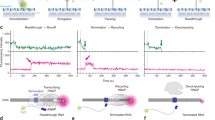Abstract
The transcription termination factor Rho from Escherichia coli is a ring-shaped homo-hexameric protein that preferentially interacts with naked cytosine-rich Rut (Rho utilization) regions of nascent RNA transcripts. Once bound to the RNA chain, Rho uses ATP as an energy source to produce mechanical work and disruptive forces that ultimately lead to the dissociation of the ternary transcription complex. Although transcription termination assays have been useful to study Rho activity in various experimental contexts, they do not report directly on Rho mechanisms and kinetics. Here, we describe complementary ATP-dependent RNA–DNA helicase and streptavidin displacement assays that can be used to monitor in vitro Rho’s motor activity in a more direct and quantitative manner.
Access this chapter
Tax calculation will be finalised at checkout
Purchases are for personal use only
Similar content being viewed by others
References
Roberts J. W. (1969) Termination factor for RNA synthesis. Nature 224, 1168–1174.
Ciampi M. S. (2006) Rho-dependent terminators and transcription termination. Microbiology 152, 2515–2528.
Richardson J. P. (2002) Rho-dependent termination and ATPases in transcript termination. Biochim. Biophys. Acta. 1577, 251–2560.
Skordalakes E. and Berger J. M. (2003) Structure of the rho transcription terminator. Mechanism of mRNA recognition and helicase loading. Cell 114, 135–146.
Skordalakes E. and Berger J. M. (2006) Structural insights into RNA-dependent ring closure and ATPase activation by the Rho termination factor. Cell 127, 553–564.
Lowery-Goldhammer C. and Richardson J. P. (1974) An RNA-dependent nucleoside triphosphate phosphohydrolase (ATPase) associated with rho termination factor. Proc. Natl. Acad. Sci. USA 71, 2003–2007.
Brennan C. A., Dombroski A. J., and Platt T. (1987) Transcription termination factor rho is an RNA-DNA helicase. Cell 48, 945–952.
Guerin M., Robichon N., Geiselmann J., and Rahmouni A. R. (1998) A simple polypyrimidine repeat acts as an artificial Rho-dependent terminator in vivo and in vitro. Nucleic Acids Res. 26, 4895–4900.
Richardson J. P. (1982) Activation of rho protein ATPase requires simultaneous interaction at two kinds of nucleic acid-binding sites. J. Biol. Chem. 257, 5760–5766.
Zalatan F., Galloway-Salvo J., and Platt T. (1993) Deletion analysis of the Escherichia coli rho-dependent transcription terminator trp t′. J. Biol. Chem. 268, 17051–17056.
Chen C. Y. and Richardson J. P. (1987) Sequence elements essential for rho-dependent transcription termination at lambda tR1. J. Biol. Chem. 262, 11292–11299.
Bogden C. E., Fass D., Bergman N., Nichols M. D., and Berger J. M. (1999) The structural basis for terminator recognition by the Rho transcription termination factor. Mol. Cell 3, 487–493.
Wei R. R., and Richardson J. P. (2001) Identification of an RNA-binding site in the ATP binding domain of Escherichia coli Rho by H2O2/Fe-EDTA cleavage protection studies. J. Biol. Chem. 276, 28380–28387.
Walmacq C., Rahmouni A. R., and Boudvillain M. (2004) Influence of substrate composition on the helicase activity of transcription termination factor Rho: reduced processivity of Rho hexamers during unwinding of RNA-DNA hybrid regions. J. Mol. Biol. 342, 403–420.
Walmacq C., Rahmouni A. R., and Boudvillain M. (2006) Testing the steric exclusion model for hexameric helicases: substrate features that alter RNA-DNA unwinding by the transcription termination factor Rho. Biochemistry 45, 5885–5895.
Schwartz A., Walmacq C., Rahmouni A. R., and Boudvillain M. (2007) Noncanonical interactions in the management of RNA structural blocks by the transcription termination rho helicase. Biochemistry 46, 9366–9379.
Schwartz A., Margeat E., Rahmouni A. R., and Boudvillain M. (2007) Transcription termination factor Rho can displace streptavidin from biotinylated RNA. J. Biol. Chem. 282, 31469–31476.
Nowatzke W., Richardson L., and Richardson J. P. (1996) Purification of transcription termination factor Rho from Escherichia coli and Micrococcus luteus. Methods Enzymol. 274, 353–363.
Geiselmann J., Yager T., Gill S., Calmettes P., and von Hippel P. (1992) Physical properties of the Escherichia coli transcription termination factor rho. 1. Association states and geometry of the rho hexamer. Biochemistry 31, 111–121.
Kao C., Rudisser S., and Zheng M. (2001) A simple and efficient method to transcribe RNAs with reduced 3′ heterogeneity. Methods 23, 201–205.
Acknowledgments
We apologize to our colleagues, especially past and present members of the Platt, Richardson, Roberts, and von Hippel labs, whose fantastic work on Rho cannot be exhaustively cited here. We gratefully acknowledge J.M. Berger, J.P. Richardson, and P.H. von Hippel for the gift of materials. Special thanks to A.R. Rahmouni, head of the ‘RNP interactions and therapeutic applications’ lab at Centre de Biophysique Moléculaire, for his constant support and stimulating discussions. This work was supported by grants from the Agence Nationale de la Recherche (PCV06-135253), the Conseil Régional du Centre (CPR 07.09.24), the Association pour la Recherche sur le Cancer (grant #3639), and the Ligue contre le Cancer (région Centre).
Author information
Authors and Affiliations
Editor information
Editors and Affiliations
Rights and permissions
Copyright information
© 2009 Humana Press, a part of Springer Science+Business Media, LLC
About this protocol
Cite this protocol
Boudvillain, M., Walmacq, C., Schwartz, A., Jacquinot, F. (2009). Simple Enzymatic Assays for the In Vitro Motor Activity of Transcription Termination Factor Rho from Escherichia coli . In: Abdelhaleem, M. (eds) Helicases. Methods in Molecular Biology, vol 587. Humana Press, Totowa, NJ. https://doi.org/10.1007/978-1-60327-355-8_10
Download citation
DOI: https://doi.org/10.1007/978-1-60327-355-8_10
Published:
Publisher Name: Humana Press, Totowa, NJ
Print ISBN: 978-1-60327-354-1
Online ISBN: 978-1-60327-355-8
eBook Packages: Springer Protocols



